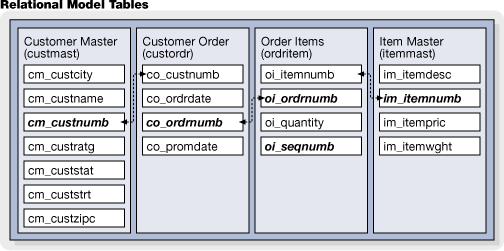php.sql.pdo\tutorials\PHP_Tutorial2.php
Now we will build some table/file relationships using the FairCom DB PHP Interface and the PDO (PHP Data Objects) extension to PHP.
This tutorial will advance the concepts introduced in the first tutorial by expanding the number of tables. We will define key columns/fields and create specific indexes for each table to form a relational model database.
Like all other examples in the c-tree tutorial series, this tutorial simplifies the creation and use of a database into four simple steps: Initialize(), Define(), Manage(), and You’re Done() !
Tutorial #2: Relational Model and Indexing
Here we add a bit more complexity, introducing multiple tables, with related indices in order to form a simple "relational" database simulating an Order Entry system. Here is an overview of what will be created:

Note our simple PHP script:
<?php
print("<html>\n");
print("<head>\n");
print("\t<title>PHP Tutorial 2</title>\n");
print("</head>\n");
print("<body>\n");
//
// Implementation of the concept of "init, define, manage and you're done..."
//
$session = Initialize();
Defines($session);
Manage($session);
Done($session);
//
// The functions are defined in the next sections of this tutorial.
//
print("</body>\n");
print("</html>\n");
// end of PHP_Tutorial2.php
?>
We suggest opening the source code with your own editor.
Continue now to review these four steps.